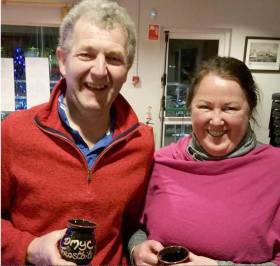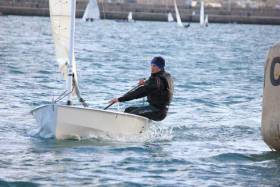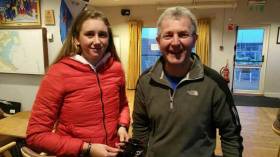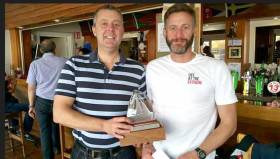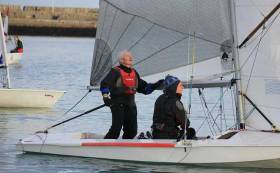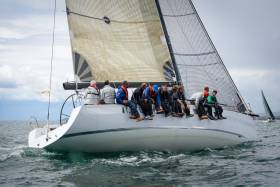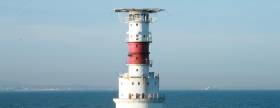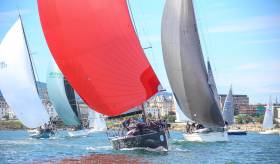Displaying items by tag: dmyc
DMYC Dinghy Frostbites on the Double!
The fifth round of the 2017/18 Frostbites, hosted by Dun Laoghaire Motor Yacht Club, saw two races held inside the harbour, a four lap trapezoid course to start proceedings followed by a three lap windward-leeward course which I am reliably informed is a first for the Frostbites, so kudos to Race Officer Brian Mulkeen writes Cormac Bradley. It also saw the best turnout of Fireballs, six and a healthy fleet of Lasers, fourteen. In addition to the six Fireballs the Fast PY Class included the 470 and Tom Murphy’s K1. In the Slow PY the fleet was made up of a Wayfarer, a Solo, a solitary KONA (Windsurfer), a Feva, 2 IDRAs, 2 Enterprises, 4 Laser Vago XDs and a Hartley 12.2.
The weather station in the harbour was recording 15.9knots with a gust of 21.8knots from 284˚ with an air temperature of 9˚. This meant that the “on-the-water” situation was pretty consistent with the XCWeather prediction for the afternoon. The afternoon started under partial blue skies but the skyline greyed as the afternoon progressed and there was a lit bit of drizzle later one. For the trapezoid course the weather mark had been set under the West Pier of the harbour at the location of the first “elbow” in the wall – where it changes direction. No.2 seemed to be a long way downwind of the first mark, almost disproportionately so, but during the race mark 1 – 2 was invariably tight. Mark 2 – 3 was an easier sail with some boats electing to gybe before reaching No.3 so as to set themselves up for a very tight 3 – 4 leg. Mark 3 was located off the HSS gantry and Mark 4 was of the order of 120m east of the mouth of the harbour.
In all three starts the fleet went left initially. In the slow PY, the Wayfarer was the weather-most boat and that set Monica Schaeffer and Miriam McCarthy up for the lead and the privilege of leading the Slow PY fleet around the first weather mark. However, they were kept in close company for the first lap by the Solo of Shane McCarthy before he was able to pull away from them. Both would fall victim on the water to the Kona Windsurfer of Robbie Walker who led for the majority of the race.
The Fireballs were stacked windward to leeward on a port tack coming out of the start towards the middle of the harbour. Using headgear and clothing combinations to identify boats it looked as though Louise McKenna & Hermine O’Keeffe (14691) were the furthest boat to windward with Neil Colin & Margaret Casey (14775) furthest to leeward. In between were Noel Butler & Marie Barry (15061), Alistair Court & Gordon Syme (14706), Frank Miller & Grattan Donnelly (14713) and David and Michael Keegan (14676).
While the boats which came furthest left seemed to have got in to better wind, Butler & Barry, having tacked earlier were able to get around the weather mark first but it was close with Miller & Donnelly and Court & Syme. Colin & Casey were a short distance behind them while McKenna & O’Keeffe and Keegan & Keegan were a little off the pace.
Court & Syme powered over Miller & Donnelly on the tight reach between 1 and 2 and spent the rest of the race chasing Butler & Barry. On the subsequent beats, the addiction to going left was diluted somewhat with a preference to staying on the right-hand side as far as the harbour mouth, before tacking across to the middle of the harbour. The exception to that rule was Colin & Casey who tacked early every time to work the middle and left of the beat. On the third lap, Butler pulled away from Court and both boats put distance between themselves and the remainder of the fleet. By Mark 3 of the penultimate lap, Butler & Barry were the third boat on the water behind the Kona and the Solo and by the penultimate rounding of Mark 4 Court & Syme were ahead of everyone bar the Kona and the Solo. The tightness of the leg from 3 to 4 meant that in Round 3 Butler & Barry went for an Aussie drop two-thirds of the way down the leg while the all male combinations behind them, Court and Miller were able to hold the spinnaker all the way into the mark.
While Butler was comfortably ahead at the last windward mark, he nearly got caught by Court who was able to close in better wind with Syme on full trapeze between 1 and 2 while Barry was sitting inboard with a limp spinnaker. However, a late change in leader did not materialise and Butler & Barry won by 50 seconds with only he Kona ahead of them on the water. Court finished third on the water, getting ahead of the Solo just before the last weather mark. Colin & Casey put together a fast last lap, closing dramatically on Miller & Donnelly in the approach to Mark 4 for the last time, but Miller held on to finish third. In the slow PY fleet, the order on the water was Kona, Solo, Wayfarer, Feva, and Enterprise.
The ice was broken (figuratively) when a second race was set for the afternoon. Marks 2 and 3 were lifted and a windward-leeward was set with Marks 1 and 4 staying “as is”. Again, the majority view in all starts was to go left – there were no dissenters in the Slow PY start, 4 Lasers went right and while all the Fireballs started on port tack, two went right quite early on – McKenna and Keegan. Colin was furthest away from the committee boat at the start. At the top mark, Miller led the fleet around followed by Butler, Court and Colin. While the first three stayed on starboard tack, Colin gybed and sailed towards the harbour mouth. Behind these four, McKenna and Keegan had their own race. Miller held the lead down to 4 and stayed ahead up the next beat. In this regard he was helped by being on starboard with a Laser also being on starboard to force Butler to take evading action relative to both boats two-thirds of the way up the second beat. At the windward mark for the second time, Colin was still in fourth, but took a line that brought him down the right hand side of the run relative to the others who were all to his port-hand side. In this position he managed to sail through Court and close the gap on the first two, but Court nipped in again at the leeward mark to relegate him back to fourth again. McKenna and Keegan were also having a “ding-dong” battle on the downwind leg.
Up the final beat and Court stays right whereas the others come left. Butler gets through Miller and Colin is promoted to third as he, Miller and Butler come in on the starboard lay-line. Court’s race come to an early end when he gets caught up in a melee at the weather mark and decides that discretion is the better part of valour and retires home early. Butler and Miller dice again on the last downwind leg but Butler secures the inside berth on the approach to the leeward mark and has enough room to squeeze Miller out and to enough of a degree to make the short hitch to the finish a “safe bet”.
In the Fast PY fleets, the Fireballs all saved their time on the water in both races which means that the Frostbite Mugs for the day go to Alistair Court and Gordon Syme for the first race of the day and to Neil Colin and Margaret Casey for the second race.
|
DMYC Frostbites: Overall Fast PY Fleet |
|
R1 |
R3 |
R4 |
R5 |
R6 |
Tot |
|
|
1 |
Noel Butler & Marie Barry |
FB 15061 |
1 |
2 |
1 |
1 |
1 |
6 |
|
2 |
Frank Miller & Ed Butler/Cormac Bradley/Grattan Donnelly |
FB14713 |
2 |
5 |
2 |
3 |
2 |
14 |
|
3 |
Neil Colin & Margaret Casey |
FB14775 |
3 |
7 |
3 |
4 |
3 |
20 |
|
4 |
Alistair Court & Gordon Syme |
FB14706 |
7 |
3 |
5 |
2 |
8 |
25 |
Tight Racing for the Fireballs at DMYC Dinghy Frostbites
The fourth Sunday of the 2017/18 Frostbite Series, hosted by Dun Laoghaire Motor Yacht Club, saw blustery conditions from a westerly direction and cool temperatures under a blue sky that clouded up as the afternoon wore on! The XCWeather forecast was for 12/13 knots with gusts of 18 – 20 knots and that was pretty much how it felt on the water. Five Fireballs made the start with a sixth ashore, afflicted by a broken gooseneck, and they enjoyed some close racing on the trapezoid course with five laps set as the course duration. In addition to the five Fireballs there was a Finn (Hugh Sheehy) a 470 (Gerry Ryan & John McAree) and a RS400 (Stuart Harris) making up the PY fleet.
Two practice laps followed by a reconnaissance of the start line suggested that a) the pin was the place to start and b) that spinnaker flying would be very much dependent on the wind conditions at the time rather than the course configuration and geometry.
Our (Miller & Bradley, 14713) to a pin-end start was thrown awry when Neil Colin & Margaret Casey (14775) came charging down the line from the committee boats end. Additionally we found ourselves a few seconds too early and both boats were obliged to gybe out and start on port tack. Alistair Court & Gordon Syme (14706) and Noel Butler & Marie Barry (15061) were closer to the committee boat but when Miller cut the start line he had to duck both these transoms on his way out to the right-hand side of the course……..which was not the original plan!
The other four Fireballs went hard left and as the two contingents converged on the weather mark it appeared as though the left-hand side had paid off. Miller crossed behind Butler but ahead of Court as he came across on starboard and by the time he had tacked to finalise his approach to the mark on the port lay-line, Court had also eked ahead. Meanwhile Colin & Casey were not too far away and as the first four boats rounded the mark the order was Butler, Court, Miller, Colin though only about eight boat-lengths separated 1st to 4th. Butler’s spinnaker hoist got snagged which allowed Court and Miller to go through his wind while Colin also closed the gap from behind. While Mark 2 was geometrically in the right location, and in the channel leading to the inner marina, the wind had gone slightly forward and the leg from 1 to 2 was a tight reach. Mark 2 to Mark 3 was broader and the places changed again with Court consolidating his place at the front and the other three boats closing in on each other. Court led around Mark 4 and went right initially. Butler rounded second and took an early hitch to the left. Miller rounded third and followed Court, while Colin also went left.
Miller was obliged to tack away to the left as he was starting to suffer from Court’s dirty wind and this proved to be an astute move because when the fleet converged again in the vicinity of the second weather mark, Miller had taken the lead followed by Court and Butler with Colin only just behind them. Again the wind was variable in direction, relative to the geometry of the course, and this time the legs from one to two and two to three were broader than before. Miller led for the next two laps (3 & 4) until the penultimate rounding of Mark 3. At this stage Colin had moved into second place, followed by Butler while Court had dropped off the pace. Later it transpired that Court’s outhaul on the main had come undone and while he got it back in place it wasn’t perfect. On the leg from 2 to 3, Colin occupied the inside berth relative to Miller with the boats overlapped. Rather than gybing immediately at Mark 3, Colin sailed on for a short distance, pinning Miller on the outside. Butler rounded behind them, unfettered, gybed immediately and sailed off inside the two boats to lead the race round the last lap. Colin’s spinnaker gybe went skewwhiff allowing Miller to get to windward and into second place though Colin came back with a vengeance to close the gap at Mark 4 to half a boat length.
While Butler sailed the last lap in clear air, Miller kept an eagle eye on Colin and at the finish the time intervals were:- Butler to Miller, 25 seconds, Miller to Colin, 10 seconds, Colin to Court, 38 seconds.
While the conditions had started blustery and gusty they eased as the afternoon wore on but the crews were “full-trapezing” on the upwind legs. In real-time terms Butler had 4:25 on the Finn and 5:14 on the 470 on the water but after the application of handicaps this reduced to 56 seconds and 4:48 respectively. The Fireballs finished 1, 2, 3, 5, and 7 with the Finn fourth on corrected time and the 470 in sixth. As Butler & Barry had won the Frostbite Mugs on the first Sunday, the day’s Mugs went to Miller and Bradley.
|
DMYC Frostbites: Round 4; 26/11/17: Fast PY Fleet |
|||
|
1 |
Noel Butler & Marie Barry |
15061 |
NYC |
|
2 |
Frank Miller & Cormac Bradley |
14713 |
DMYC |
|
3 |
Neil Colin & Margaret Casey |
14775 |
DMYC |
|
4 |
Hugh Sheehy (Finn) |
2 |
|
|
5 |
Alistair Court & Gordon Syme |
14706 |
DMYC |
|
6 |
Gerry Ryan & John McAree (470) |
777 |
|
|
7 |
David & Michael Keegan |
14676 |
RStGYC |
|
DMYC Frostbites: Overall Fast PY Fleet |
R1 |
R2 |
R3 |
R4 |
Tot |
|
|
1 |
Noel Butler & Marie Barry |
1 |
Cancelled |
2 |
1 |
4 |
|
2 |
Frank Miller & Ed Butler/Cormac Bradley |
2 |
5 |
2 |
9 |
|
|
3 |
Hugh Sheehy (Finn) |
7 |
1 |
4 |
12 |
|
|
4 |
Neil Colin & Margaret Casey |
3 |
7 |
3 |
13 |
|
|
5 |
Alistair Court & Gordon Syme |
7 |
3 |
5 |
15 |
|
Wayfarer Beats MacCarthy's Solo After Course Error at DMYC Frostbite Race
After having to call off last Sunday’s racing due to an excess of wind at the DMYC dinghy Frostbite Series, the challenge today was to get a race in in a dearth of wind writes Cormac Bradley. Though the forecast was for 10–knot southerlies, the water inside the harbour was mirror-like though that too proved deceptive as, on launching, there was enough wind to get out to the race area unassisted. Direction-wise it was also out of synch as a southerly was predicted but it was in the eastern quarter for the entirety of the afternoon.
A fleet of just over thirty boats took to the water with the Lasers and slow PY the largest fleets. A reduced fast PY fleet was made up of a Finn, three Fireballs, a 470 and an RS 400. Race Officer for the day was Ben Mulligan of the Flying Fifteen Class who set a course of 4 laps of a triangular configuration, with a weather mark in the vicinity of the HSS docking station and a gybe mark just inside the end of the East Pier. The first two starts suggested that the place to start was at the committee boat end which is where the three Fireballs located themselves. Unusually, Noel Butler, crewed by sailing globetrotter Shane Diviney, was late to the start but it turns out this was due to the later finish of the keelboats who were also adversely impacted time-wise by the light winds.
His late arrival only served to delay his assumption of the lead, halfway up the second beat. He trailed behind Frank Miller & Cormac Bradley (14713) and Alistair Court & Gordon Syme (14706). Initially, Miller & Bradley pulled away from the other two and Butler & Diviney were the first to break ranks, going right for a short distance. Shortly afterwards, Court & Syme did the same while Miller & Bradley persevered with a starboard tack approach to the weather mark.
Court was able to close the gap and then take advantage of the proximity of the Finn to Miller’s weather, blocking a tack by Miller, to round the weather mark first. Going down the two spinnaker legs Miller was able to eke out a short lead and surprisingly Butler wasn’t able to close the gap too Miller.
On the second beat Butler went hard left, whereas the other two went right. Court broke first but Miller went that bit further. When he crossed tacks he was still ahead of Court, but Butler was gone!
Court managed to recover to round the weather mark marginally ahead of Miller but just behind the Finn. A luffing match then ensued between Court and the Finn which took them on a course almost at ninety degrees to the straight line to the gybe mark. This allowed Miller to assume second place which he held to the leeward mark. Up the third beat and Miller managed to hold off Court to the weather mark, but only just. Court “powered” over Miller and was never passed again.
The finishing order over the line was Fireball, Fireball, RS 400, Fireball, and Finn. However, on corrected time the win went to the Finn and the first two Fireballs filled the podium positions. The 470 beat Miller to fourth and the RS 400 closed it out.
In Fireball terms this leaves Butler with two first places followed by Miller with a 2nd and a 3rd.
In the slow PY fleet, the handicap win was taken by the Wayfarer of Monica Schaeffer & Miriam McCarthy ahead of the Solo of Shane McCarthy and the Kona (windsurfer) of Robbie Walker. What makes McCarthy’s performance all the more commendable is that he sailed the second lap as a sausage but sailed all the way back to the gybe mark to correct his mistake.
In the Laser Class, six full rigs led the charge before the first Radial and first lady featured – Shirley Gilmore. The Class win went to Jeff Brouder, followed by Alan Hodgins and Luke Dillon.
The Fireball Class have their end of season dinner and prize-giving this Friday coming in the National Yacht Club. Due to a coinciding event a number of Fireball regulars will be attending another Class dinner at the same venue so they will play a part-time role in the Fireball occasion. If you want to come along to the Fireball dinner, please let us know so that we can add you to the numbers. In terms of the regatta planning for next season, a number of options have been developed and we are hopeful of getting the calendar closed out in the reasonably near future.
47th Dun Laoghaire Dinghy Frostbite Series Gets Underway!
The 47th running of Dun Laoghaire Motor Yacht Club’s Frostbite Series got underway yesterday in blue sky, sunny conditions and a brisk N-Westerly that reduced in strength as the afternoon wore on writes our special correspondent. Stalwart of the event, Olivier Prouveur, who announced at the conclusion of the 2016/17 Series that he would be taking a less prominent role in the managing of the event was in attendance, but in an observer role!
The Race Officer duty was undertaken by Frostbite RO debutant Cormac Bradley of the Fireball Class and for his first foray into the Frostbite Race Management the first decision was to decide if racing would take place. An early departure from DMYC with a suggestion that a postponement would be advised, if necessary, was vindicated when the assessment was that racing could proceed.
In a departure from previous formats, three starts were provided – Slow PY, (PY1), Lasers and Fast PY (PY2). And in a significant development, two windsurfers of the KONA Class joined in the racing.
Given the conditions and the “first day back” nature of the day, a single race was proposed and sailed with 5 laps of a trapezoid course used to wash away the cobwebs. Given that the keelboats, sailing their Turkey Shoot Series earlier in the morning, did not seem to be excessively hard pressed and taking into account the physical condition of the waters inside the harbour, the postponement wasn’t required and racing got underway on schedule, at 14:00.
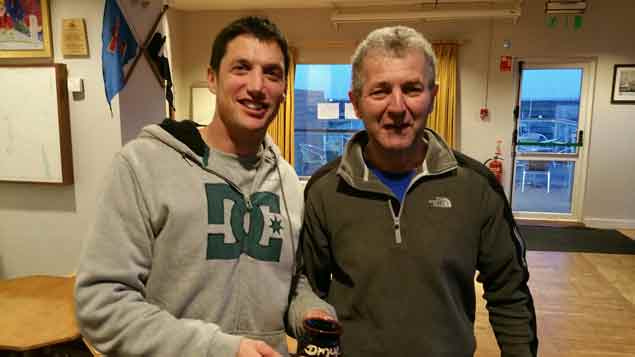 Solo sailor Shane McCarthy (left), the Slow PY Class winner with DMYC's Neil Colin Photo: Frank Miller
Solo sailor Shane McCarthy (left), the Slow PY Class winner with DMYC's Neil Colin Photo: Frank Miller
As an experiment the two windsurfers were put in PY1, the argument being that if they were as fast as we thought they might be they would get away from the rest of the fleet and have less traffic to deal with on the race course. Their contemporaries on the first start were a Solo, an IDRA 14 and four Laser Vagos. One of the Konas led at the first weather mark, sitting about 60m inside the harbour mouth and closer to the end of the West Pier, but the Solo was not far behind. By the time they got to the end of the five laps, the windsurfer had a good lead on the Solo on the water, but was unable to save his time in handicap terms. In third place on the water was the IDRA of Pierre Long & John Parker. Marks 2 and 3 were in the vicinity of the approach to the marina and just east of the ferry terminal respectively and while spinnakers were a rarity on the top leg of the trapezoid, they were flown on the leg from 2 to 3. Again, only the asymmetrics had any real joy with spinnakers on the bottom leg of the course. Mark 4 was in the approximate location of the memorial on the East Pier.
The finishing order on the water was Kona, Solo, IDRA, but after handicap correction the win went to the Solo of Shane McCarthy with the windsurfer second and the IDRA third.
Ten Lasers answered the starter’s call, with three Radials in the bunch. And it was one of the Radials, helmed by Clare Gorman who set the pace for the first half of the course. Eventually she was reeled in by Gary O’Hare who went on to win on the water by 24 seconds, but after handicap correction, Gorman took the first Laser Frostbite Mug by a margin of 1:09. In third place was Richard Tate.
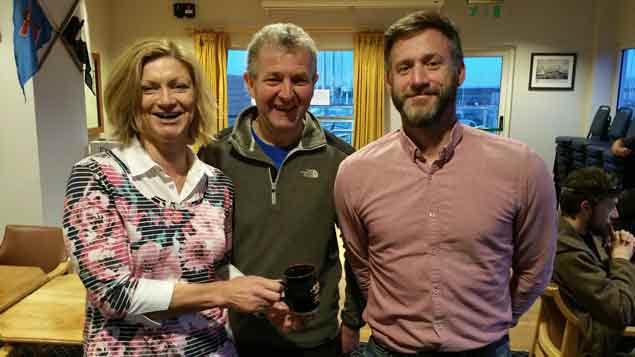 Fireballers Marie Barry and Noel Butler (right) the fast PY Class winners with DMYC's Neil Colin Photo: Frank Miller
Fireballers Marie Barry and Noel Butler (right) the fast PY Class winners with DMYC's Neil Colin Photo: Frank Miller
Six Fast PYs populated the last start of the day, four Fireballs, a K1 and an RS400. Noel Butler with new crew, Marie Barry (15061) led the fleet from start to finish and won with a 1:24 margin. They weren’t seriously troubled at any stage of the race and even tired spinnaker on the top reach but the blustery nature of the wind coming over the wall suggested that discretion was the better part of valour. Behind them, the battle was for second and third and was populated by Frank Miller & Ed Butler (14713) and Neil Colin & Margaret Casey (14775). While the former pair had the better start and led during the early part of the race, they were undone by an incident with a Laser at one of the leeward mark roundings. The Laser went the wrong side of the mark and got his mainsheet snagged on the mark. This cause him to go into a slow painful capsize with his mast and main snagging the trapeze wire of crew Ed Butler who subsequently went swimming. However, Miller & Butler recovered to take second place back from Colin & Casey. They cut it very fine though, only six seconds separating the two boats. The Fireballs, Butler & Barry, Miller & Butler, Colin & Casey and son and father combination, David & Michael Keegan (14676), were the first four boats home and on handicap. Tom Murphy (K1) only just beat the RS400, helmed by Stuart Harris, on the water, but beat them more comfortably on corrected time.
During the hour’s racing the wind eased as forecast and the blue sky conditions made for a good day out. Frostbites 2017/18 is up and running.
DMYC’s Frostbites 2017/18 – Day 1.
PY1 – Slow Handicap
1 Solo Shane McCarthy Coal Harbour 5302
2 Kona TBA 1969
3 IDRA Pierre Long & John Parker DMYC 161
4 Kona Des Gibney 2677
Lasers
1 Radial Claire Gorman NYC 207800
2 Full Gary O’Hare RStGYC 201364
3 Full Richard Tate 186300
4 Full Gavan Murphy 173062
PY2 – Fast Handicap
1 Fireball Noel Butler & Marie Barry NYC 15061
2 Fireball Frank Miller & Ed Butler DMYC 14713
3 Fireball Neil Colin & Margaret casey DMYC 14775
4 Fireball David & Michael Keegan RStGYC 14676
5 K1 Tom Murphy NYC 59
For a first day of the series, the entries were down on previous years, this was assumed to be a combination of the forecast, the preceding week’s mid-term break for schools and the usual need to get momentum developed. The organisers would welcome more entries in the forthcoming Sundays.
Laser & Two PY Fleets for DMYC's Dinghy Frostbite Series
Dun Laoghaire Motor Yacht Club (DMYC) starts its 47th Season of dinghy frostbite racing in Dun Laoghaire Harbour this Sunday with a warning signal at 01.57 hrs.
The series is open to monohull centre board dinghies and attracts entries from clubs in the greater Leinster area.
The Winter 2016 series saw 19 races over the period November to the end of March. Organiser Neil Colin of the DMYC says the popular series 'offers great value for money, and with the discard system in the results, eases the pressure to turn up every week'.
In response to the changing dynamic of the entrants, with exception of the Lasers, the balance of the fleet will race in two PY fleets with the cut off set at 1068 between fleet 1 & 2, as further detailed in the Sailing Instructions.
Daily “Mug” prizes will be presented after racing in the DMYC, with soup and refreshments available along with the post race chatter.
The DMYC have limited dinghy parking for visiting entries on a “first come” basis. Full details are available here. Download the poster below.
Irish Fireball Sailing Regatta Season Comes to a Close!
The Irish Fireball regatta season came to an end with a four-race Munster Championships in Dun Laoghaire yesterday (Saturday 14th). The irony of course is that Dun Laoghaire isn’t in Munster at all, of course, but the Association is cutting its cloth according to its numbers and an offer from the Dun Laoghaire Motor Yacht Club to host the event was readily accepted. With an expectation of low numbers, the regatta organisation structure was minimised to two ribs and 3 people and the course configuration was reduced to a windward-leeward option.
Race Officer, Cormac Bradley, ably assisted by Alistair Court and Charles Dunn, was tasked with getting four races in and watching the weather forecast during the week before, the challenge would be to get them in before the weather closed in. While XCWeather was suggesting that the base wind strength would be of the order of 12 – 15 knots, the gusts were projected to start off at 20 knots and grow to 27 knots as the day wore on. At the briefing the six-boat fleet were made aware of the forecast , the impending gustiness of the day and the programme to get 4 races in and to get off the water before the weather got “hooligan”…………and this was not due to the impending blast of Ophelia!
The saving grace on the day was that the wind direction was SSW meaning that the sailing area was in flat water. The sailing area was to the west of Dun Laoghaire harbour and with the slimmed down organisation the start, finish and gate of the windward-leeward course were coincident. This meant that the windward mark could be moved relative to the other two fixed points of the course.
Contrary to the weather forecast, only the first race was a blustery affair that generated a few capsizes, but none of the capsizes I witnessed were due to wind strength, so maybe only one was due to wind strength and that happened before the start. As the day wore on the wind eased, the sun came out and “full-on trapezing” upwind gave way to sitting on the windward deck. Race lengths were of the order of 30 – 40 minutes and 3 or 4 laps, with race times and laps increasing as it became apparent that the projected wind conditions were not going to materialise.
Proceedings on the water were dominated by the usual suspects – Messrs Butler and Oram (15061, NYC) – but they didn’t have everything their own way. Class Chairman Neil Cramer, crewing for Niall McGrotty (14938, Skerries Sailing Club) led Race 2 until the last leeward mark before they were passed before the last weather mark. Indeed, at one stage they had dropped back to third on the water, with Neil Colin & Margaret Casey (14775, DMYC) getting into second. However, the ultimate measure of success is the sequence across the finish line and in this regard Butler and Oram reigned supreme with four wins.
The competition for second and third was a tighter affair between McGrotty/Cramer and Colin/Casey and went the way of the former combination by way of a more favourable ratio of second places on the water, 3:1. It might even have been a bigger margin if the Skerries combination hadn’t capsized in Race 3 when they were in a strong second place – they finished sixth.
For the balance of the fleet – Frank Miller & Peter Doherty (14713, DMYC), Mick Creighton & Marie Barry (14854, NYC) and Louise McKenna & Hermine O’Keeffe (14691, RStGYC), the “pink ladies”, it was a case of sharing the lesser places and two of the three had race capsizes that cost each of them.
|
2017 Fireball Munsters, Dun Laoghaire Motor Yacht Club October 14th |
R1 |
R2 |
R3 |
R4 |
Gross |
Nett |
|||
|
1 |
Noel Butler & Stephen Oram |
15061 |
National Yacht Club |
1 |
1 |
1 |
1 |
4 |
3 |
|
2 |
Niall McGrotty & Neil Cramer |
14938 |
Skerries Sailing Club |
2 |
2 |
6 |
2 |
12 |
6 |
|
3 |
Neil Colin & Margaret Casey |
14775 |
Dun Laoghaire Motor Yacht Club |
3 |
3 |
2 |
3 |
11 |
8 |
|
4 |
Frank Miller & Peter Doherty |
14713 |
Dun Laoghaire Motor Yacht Club |
8 |
4 |
3 |
4 |
19 |
11 |
|
5 |
Mick Creighton & Marie Barry |
14854 |
National Yacht Club |
4 |
6 |
5 |
5 |
20 |
14 |
|
6 |
Louise McKenna & Hermine O’Keeffe |
14691 |
Royal St. George Yacht Club |
8 |
5 |
4 |
6 |
23 |
15 |
For 15061 this completes a season “Grand Slam” of all the Provincial titles, the Nationals and the Dublin Bay Sailing Club Series. While Stephen was absent for the Nationals, Noel helmed the boats to each of these titles.
After the racing, prize-giving and post-mortems the Class held its AGM in the DMYC clubhouse.
In his Chairman’s address Neil Cramer highlighted the fact that although Noel & Stephen had dominated the top spot on the podium there had been a wide spread of combinations filling the lowers steps of the podium. His report also reflected the various formats the regattas of the season had taken – a three-day, nine race Nationals at Lough Derg with SODs, Mirrors and Squibs as part of their Harvest Regatta, a two-day six race Leinsters co-sailed with the Skerries Club Regatta, a one-day four race Open at Greystones, a two-day six race Ulsters in Ballyholme with the 420s and today’s one-day four race Munsters. The Mirrors in particular have expressed an interest in teaming up again with a view to getting their members a taste of Fireballing and a provisional arrangement to do that in Mullingar is on the agenda.
The turnout for the DBSC Tuesday Series was less than last year but was still healthy and the competition ran for the entire season. A number of the dinghy classes are anxious to get some weekend racing organised under the burgee of DBSC in 2018 and it appears the best way to achieve this objective is to nominate specific Saturdays on which this will happen.
In terms of the committee structure, there was a resignation and a slight shuffling of the seats around the table – Neil Cramer remains as Class Chairman, Frank Miller takes on the Secretary portfolio and Marie Barry that of Treasurer. Other committee members are staying on. Neil thanked all those who had served in 2017 and thanked them for their continued support.
An update on the affairs of Fireball International as discussed at the Europeans in Lyme Regis in August was tabled and the meeting was advised that we are in election mode. Current FI Commodore Steve Chesney is not seeking re-election and his successor is likely to be a lady Fireballer from Switzerland. Further discussions revolved around a motion by the UK Association that the class be able to use twin spinnaker poles and it prompted a lively discussion in the DMYC as well.
Given the numbers we have had on the water this season, the meeting closed out with a soul-searching discussion on how we get our numbers back to a respectable level. Some of the issues to be discussed were;
- The need to get younger people interested in the class.
- Diluting the perception that the Fireball can only be competitive if it is brand new.
- Undoing the perception that it is an overly expensive class to get in to.
- Marketing the flexibility of the crew combinations that can sail the boat competitively.
- Sharing venues with other classes to showcase the class
- Putting energy and training into club fleets that aren’t travelling to get them onto their own water.
The meeting was particularly encouraged that a couple had come up from Killaloe for the meeting and were able to report that two Spanish guys had joined their fleet and were keen to get a Fireball presence going again.
The day closed with a gathering of the fleet in the Purty Kitchen, a hostelry around the corner from the DMYC for dinner.
The Frostbite Series starts on the first Sunday of November and this year we will be part of the fast PY Fleet. The expectation is that we will have 6-7 boats contesting the event.
The Class Dinner takes place on November 25th in the National Yacht Club.
Entries Open For DMYC’s 2017-18 Frostbite Challenge
#DMYC - The Notice of Race for the Dun Laoghaire Motor Yacht Club’s upcoming Frostbite Challenge is now online.
The DMYC will be celebrating 47 years of winter racing in the 2017-18 Frostbite series — and entries are now open on the DMYC website.
Fees are €180 for two-handers, €150 for single-handed boats and €100 for juniors. Competitors must be members of Irish Sailing or a affiliated Category 1 club.
Races will run on Sundays in Dublin Bay or Dun Laoghaire Harbour from 5 November till 25 March (excluding 24 and 31 December) with first gun at 1.57pm.
There will be three starts each racing day, for PY2, Lasers and PY1. All boats will be raced under the Portsmouth Yardstick handicapping system.
Participants can also apply for dinghy parking at the DMYC via the website.
Greystones Yacht Wins DMYC 'Kish' Race Rerouted to North Burford
47 boats entered the 2017 edition of the DMYC Kish Race which, in this particular instance, should have been renamed the DMYC North Burford Race as the Race Officer of the day, Neil Colin, adequately judge that there was not a chance to round the Kish in these conditions writes Olivier Proveur.
Download results below as a PDF file
In stark contrast to last year where winds blew F7 to F8, the wind never got established and a paltry 3 to 5 knots 'gusting' 7 to 9 knots at the very most welcomed the competitors, some of which were really struggling to even cross the start line against a strong tide.
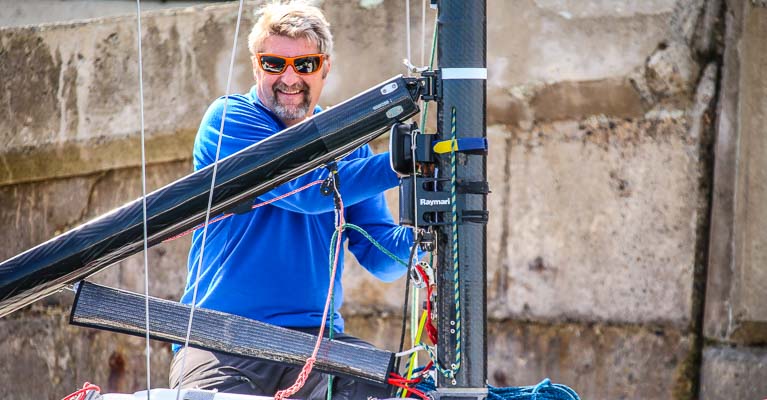 Andrew Sarratt sailing the J70 'Jheetah' from the RIYC was second overall in the light air DMYC Kish Race
Andrew Sarratt sailing the J70 'Jheetah' from the RIYC was second overall in the light air DMYC Kish Race
Many on board wished there would still be a smoker among the crew to 'light up a fag and see where that puff was coming from' but alas, there were no more puffs than smokers!
Once the on board provisions of food and drinks ran out, many decided to call it a day, some on the verge to run aground, some trailing fishing hooks in the hope of 'showing something for their day', some being just too bored, too thirsty or too afraid to use all their Brownie points at home all in one go!
Most who actually persevered managed to cross the finish line before the 16:30pm deadline and a small group of tired but enthusiastic sailors gathered on the DMYC balcony for the prize giving and a well deserved pint...
The big winner of the day was the Grand Soleil 44 Race 'Eluthera', Frank Whelan of Greystones SC, who won with a very comfortable margin of over half an hour on corrected time over second overall boat J70 'Jheetah' (Andrew Sarratt) of the RIYC showing that, in light airs, you either need a lot of canvas or a very small displacement!
DMYC look forward to the 2018 edition when race organisers have promised all competitors 'a nice F3-4 reach to and back from the Kish' after these two most contrasting years.
Entries Open & Details Announced For 2017 Kish Race
#KishRace - The Dun Laoghaire Motor Yacht Club has announced details of its annual Kish Race for 2017.
This year’s race in Dublin Bay to and from the Kish Bank Lighthouse offshore will be held on Sunday 24 September.
As previously reported on Afloat.ie, the DMYC has been hosting this yearly event since the early 1980s, beginning as a single-handed affair but more recently becoming a two-handed race for cruiser class boats under the ECHO standard.
The Notice of Race and entry form are both available now on the DMYC website.
With the success of Volvo Dun Laoghaire Regatta 2017 now universally acknowledged in highlighting the developing role of Dun Laoghaire Harbour as a major waterborne recreational centre, it is timely to remember the vital contribution made to the contemporary scene by Dun Laoghaire Marina. Since 2001, it has been quietly yet efficiently getting on with the business of providing the modern facilities which have brought the staging of international big-fleet and keelboat events comfortably within the Harbour’s annual programme. W M Nixon takes up the story
It is a historical fact that when the new Harbour was being planned in Dun Laoghaire 200 years ago, very little if any provision was made to include shore-side facilities in the overall project. The magnificent new granite structure was envisaged purely as an Asylum Harbour to shelter ships waiting to enter or leave the port of Dublin, which in those days was restricted by a shallow entrance unusable at low tide.
Far from providing those on board such vessels with convenient contact with the nearby and initially sparsely-inhabited shore, it was a matter of harbour planning policy that, ideally, there’d be no such contact whatever. Yet even at an early stage of the works, it was increasingly evident that it was potentially a magnificent amenity that would lend itself well to the expanding popular association of the seaside with leisure of all kinds, whether it be simply enjoying the bracing sea air, or interacting more dynamically with nautical activity through boat and water sports.
 The installation of Dun Laoghaire Marina was another stage in providing convenient and safe shoreside access for a harbour in which such access was originally very limited. Photo: Tim Wall
The installation of Dun Laoghaire Marina was another stage in providing convenient and safe shoreside access for a harbour in which such access was originally very limited. Photo: Tim Wall
So although the harbour was not considered finished until 1859, and to some extent has always continued as Work in Progress ever since, by 1859 a fashionable seaside town had already developed beside it, with much emphasis on harbour and sea-related events.
The recent across-the-board success of the four-day Volvo Dun Laoghaire Regatta 2017, with a diverse fleet of 475 boats taking part, was a reminder of how long this supposedly utilitarian harbour has been central to the seaborn leisure activities of the people of Dublin, and particularly those who live in the immediate south county area in what is now Dun Laoghaire-Rathdown.
In addition to the many sailing championships included in the impressive programme for 35 classes, the Regatta celebrated the Bicentenary of the beginning of work on the construction of the harbour in 1817, with 2017’s sailing programme seeing innovative Bicentenary events and special trophies. And of these trophies, arguably the most interesting were framed copies of an engraving showing the first recorded regatta at the harbour, which was staged in 1828, barely eleven year after the massive harbour works were started.
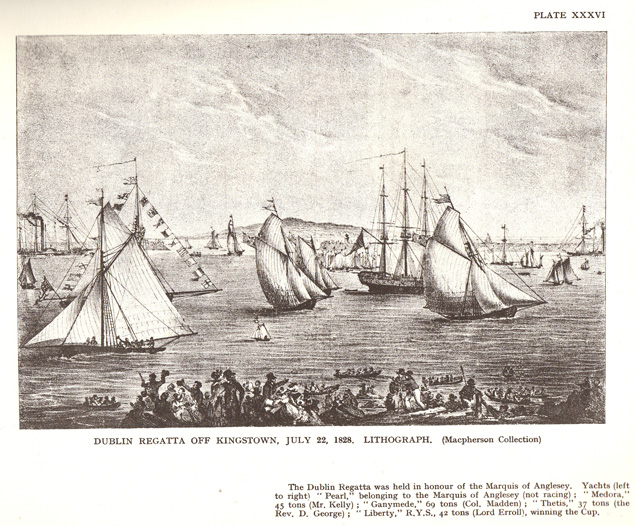 The first Regatta of 1828. Copies of this engraving were awarded as prizes in the Volvo Dun Laoghaire Bicentenary Regatta 2017.
The first Regatta of 1828. Copies of this engraving were awarded as prizes in the Volvo Dun Laoghaire Bicentenary Regatta 2017.
There had been such a demand to utilise the recreational potential of the harbour that many noted racing yachts of the day were prepared to undertake their sailing competition from a harbour which was still a building site, and with very limited shoreside amenities at that. This was to become a theme of the Dun Laoghaire story. In fact, by the time the harbour had achieved the broad outline of its finished form in 1859, the waterfront had acquired the first clubhouse of what became the Royal St George Yacht Club as long ago as 1838, while the Royal Irish Yacht Club, having briefly thrived without a shore-base clubhouse at its foundation in 1831, was revived in 1846 and by 1851 had its magnificent clubhouse, the world’s oldest complete purpose-designed yacht club building, in place on the waterfront.
This process of waterfront development continued with the Edward Yacht Club – now the National Yacht Club – completing the trio of substantial yacht club buildings on the main harbour in 1870, while in modern times it was just over fifty years ago that the Dun Laoghaire Motor Yacht Club came into being on the quayside in the inner Coal Harbour.
These four clubhouses, while diverse in character and style, all share one characteristic. They are miracles of the skillful utilisation of very limited space. For although the town may have grown rapidly because of the existence of the harbour, such was the demand for building space on the fashionable waterfront, and the need for the provision of harbourside roads and a through railway, that the buildings actually serving the needs of ships, seafaring and recreational sailing, were crowded in along a very narrow waterfront strip.
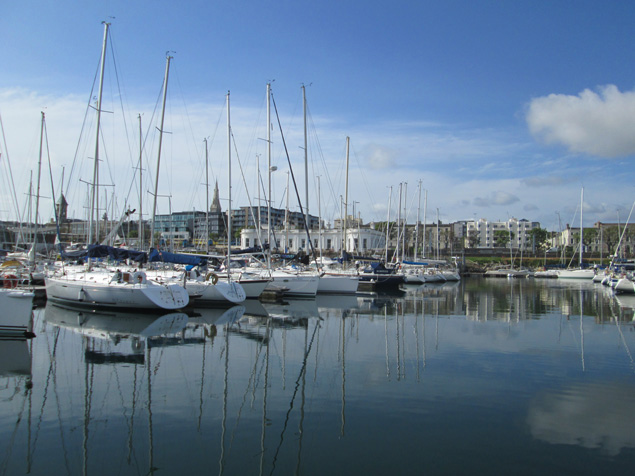 The Royal Irish YC clubhouse of 1851 as seen from the modern marina. This historic clubhouse was built and functioning eight years before the harbour was declared complete.Yet despite the severe limitations of the space available to them, the various waterfront organisations have continued to function and indeed thrive in their activities. So much so, in fact, that it could reasonably be claimed that the outstanding success of the Volvo Dun Laoghaire Regatta 2017, and particularly its Kingstown 200 celebratory highlight, has been a game-changer in reinforcing perceptions of the harbour’s potential.
The Royal Irish YC clubhouse of 1851 as seen from the modern marina. This historic clubhouse was built and functioning eight years before the harbour was declared complete.Yet despite the severe limitations of the space available to them, the various waterfront organisations have continued to function and indeed thrive in their activities. So much so, in fact, that it could reasonably be claimed that the outstanding success of the Volvo Dun Laoghaire Regatta 2017, and particularly its Kingstown 200 celebratory highlight, has been a game-changer in reinforcing perceptions of the harbour’s potential.
There is now definitely a viable future for Dun Laoghaire as a recreational leisure and sporting centre in the broadest sense, whether it be for sailing, rowing, other water sports, or simply enjoying the bracing sea air by walking the splendid main piers which - still largely in their superbly-built original form - have for so long been such an elegant aspect of Dublin Bay that many of us find ourselves thinking of them as natural features.
However, in celebrating the great events of the Regatta of July 6th to 9th 2017, there is one important element in the modern Dun Laoghaire’s provision of facilities which is sometimes overlooked. Perhaps it’s because it simply gets on with what it was planned to do in a professional and unshowy style, for whatever reason these days we tend to take the existence of Dun Laoghaire Marina for granted.
But the harbour’s contemporary year-round sailing programme, and its confident ability to provide totally secure berthing for up to 820 boats of all sizes up to superyachts and record-breaking giant multihulls, is all because of the quiet existence within it of the largest marina in Ireland, which provides hundreds of completely sheltered and fully-serviced pontoon berths in an area whicb formerly only had space for 70 swinging moorings, moorings which were by no means completely sheltered in all conditions.
And yet this facility, still seen as new, is very much of the Harbour in that, of all the diverse maritime facilities on Dun Laoghaire waterfront, it is the Marina which is most water-based. Its footprint ashore is relatively minuscule. It has been allowed just enough space on land for the administrative/reception and services building. But apart from that, its own wide-ranging facilities are completely afloat, as the travel-hoist which serves the fleet is on a different area of Harbour Company land. Although that is leased to the Marina, it is in its turn sub-contracted out to be operated by MGM Boats Ltd, the multi-functional marine trade company which includes boatyard operations within its many areas of expertise.
The long-established yacht clubs may have expanded their originally small sites to became more substantial spaces. But as the aerial photos tellingly reveal, the marina manages to provide its core activities and facilities with a minimal toehold ashore. Yet those core activities and facilities afloat are central to the sailing and boating success of modern Dun Laoghaire, and with the Marina now 16 years old – it officially opened on St Patrick’s Day 2001 – it is time and more to acknowledge its quiet yet very significant contribution.
 While the Marina is a significant presence afloat, its office footprint on the waterfront is very small, slotted in between the extended hard standing of the Royal Irish YC (right) and the marshalling yards for the former cross-channel ferry service (left).
While the Marina is a significant presence afloat, its office footprint on the waterfront is very small, slotted in between the extended hard standing of the Royal Irish YC (right) and the marshalling yards for the former cross-channel ferry service (left).
That significance can best be put into perspective by putting our minds back to 1986. While Dun Laoghaire Harbour may have been a pioneering facility in the way it developed between 1817 and 1859, by the final decades of the 20th Century it was clearly in need of modernisation, with the urgent need for the addition of properly sheltered pontoon berthing to keep it in line with facilities elsewhere - not just abroad, but also in Ireland, where places like Crosshaven, Howth and Bangor were beginning to enjoy full marina availability.
While Dun Laoghaire sailing enthusiasts of the calibre of Olympic helmsman Jimmy Mooney had been advocating a marina for years in order to offset their harbour’s seriously exposed condition in northeast gales, there was understandable resistance among those who saw the harbour as a beautiful creation in its total and original concept, even if shoreside areas of it were disfigured by the facilities required by ferries operating the cross-channel route to Holyhead.
But then in August 1986, Hurricane Charley struck. Force 12-plus northeasterlies caused enormous damage along Ireland’s East Coast, with Dun Laoghaire experiencing the perfect storm. The harbour was like a giant washing machine, and waterfront and fleet damage and loss was widespread, with classic yachts such as the Dublin Bay 24s and the Dublin Bay 21s – for so long an adornment of the harbour – suffering to such an extent that in effect it marked the end of the Dublin Bay 21s as an active class.
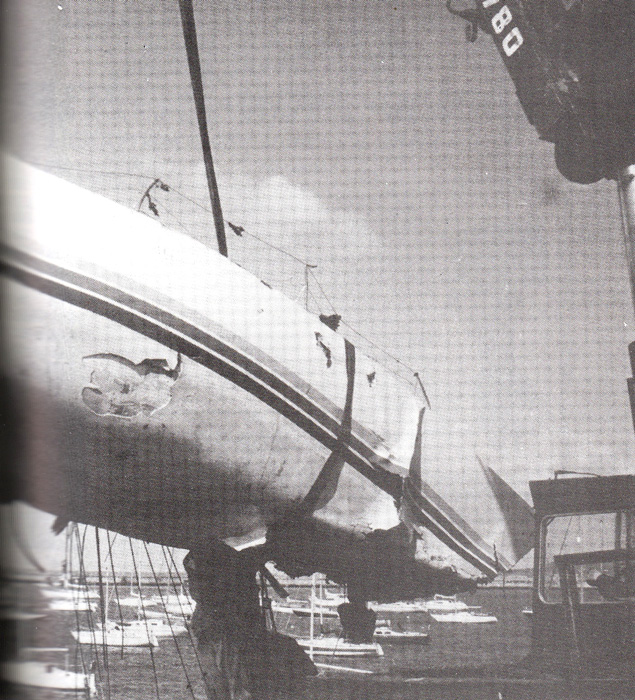 The destruction wrought by the northeast storms of Hurricane Charley in August 1986 was widespread on Ireland’s East Coast, and the Dun Laoghaire fleet saw boats of all sizes wrecked through broken moorings. This is the remains of the Sisk brother’s X40 Alliance being brought ashore – the caption tells us “this was the less-damaged side”. Photo: David O’Brien/Afloat Magazine
The destruction wrought by the northeast storms of Hurricane Charley in August 1986 was widespread on Ireland’s East Coast, and the Dun Laoghaire fleet saw boats of all sizes wrecked through broken moorings. This is the remains of the Sisk brother’s X40 Alliance being brought ashore – the caption tells us “this was the less-damaged side”. Photo: David O’Brien/Afloat Magazine
After August 1986, the provision of a proper in-harbour marina became a question of “when” rather than “if”. Knowing how long contentious planning matters can take to be resolved in Ireland, it’s actually remarkable that a new marina, located within in-harbour breakwaters of a high standard to match the quality of the main piers, was in being just 15 years and seven months after the balance was tipped in its favour by Hurricane Charley.
Of course there were many other factors involved in the successful implementation of this radical new development, and some people had been working in support of it for many years. As the new and superbly-sheltered amenity became increasingly accepted, supported and used, one of its longterm advocates famously remarked that it had taken 25 years for Dun Laoghaire Marina to become an overnight success.
It may seem strange now that the new marina seemed so strange then, but we have to remember that the Dun Laoghaire Harbour into which it was inserted 16 years ago was a very different place. It was still an active ferry port, with a fully professional harbour staff in charge of the overall administration. But while the clubs were significant employers of professional staff for their facilities afloat and ashore, those employees were in turn answerable to the voluntary democratically-elected officers of each club.
With the marina, however, everything was on a much larger scale. It had to be seen as a commercial proposition, run as a business by competent professionals who were answerable to a management company which in turn was answerable to its shareholders.
And of course the services of the marina were available to any competent boat-owner who was prepared to pay for its excellent facilities. Instead of mainly relying on a club ferry service to get you to and from your boat, you could now step on board as and when you wished. And while the marina management tried to cluster classes and groups of fellow club members in its berthing allocations if possible, it was by no means a requirement, and the relatively closed sailing community had to open its mind and attitudes to newcomers and strangers.
 Hal Bleakley became the first General Manager of the new Dun Laoghaire Marina in 2001. Photo: courtesy Dun Laoghaire Marina
Hal Bleakley became the first General Manager of the new Dun Laoghaire Marina in 2001. Photo: courtesy Dun Laoghaire Marina
It could have been impersonal, but it wasn’t, thanks to the extremely sensible selection by the owners of the marina’s General Managers. There have only been two since 2001, Hal Bleakley who was himself of the Dun Laoghaire sailing community through and through, and Paal Janson, who succeeded him in 2011 after working with him on the small but dedicated marina team for years.
Hal Bleakley was a consummate amateur sailor and race officer whose professional life had been as Maintenance Director for Aer Lingus. It was the perfect CV for a challenging job which simply hadn’t existed in the complicated Dun Laoghaire matrix before.
As for Paal Janson, as you’ll guess he’s of Norwegian descent, but he is very much of Ireland even if there’s a photo of a Janson ancestor’s sailing boat racing at Bergen in the 1920s on the walls of his office, which is more than just an office, it’s a control centre as well, as he can oversee the entire busy marina from it.
 A man and his marina – Paal Janson has been General Manager of Dun Laoghaire Marina since 2011, and has seen it receive new awards and recognition. Photo: David O’Brien/Afloat.ie
A man and his marina – Paal Janson has been General Manager of Dun Laoghaire Marina since 2011, and has seen it receive new awards and recognition. Photo: David O’Brien/Afloat.ie
Like Hal Bleakley, Paal Janson (he tends to be called Paul) brings a very useful professional background, as he was formerly a deck officer in the International Merchant Marine, accustomed to dealing calmly with all sorts of sea-related problems, and in ensuring that things run smoothly without fuss.
With a staff of ten – three for the office and the others working throughout the extensive marina itself – he has been assiduous in keeping Dun Laoghaire marina in its position of high standing among international-level yacht harbours, which is such that it became the first coastal marina among the 23 in the Republic of Ireland to achieve the coveted Five Anchor Award. This was awarded originally in 2008, but more importantly it has been retained ever since, successfully coming through rigorous annual inspections.
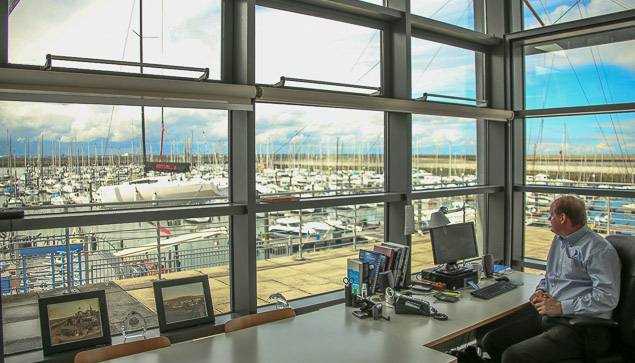 The control centre – the General Manager’s office provides the ultimate view. Photo: David O’Brien/Afloat.ie
The control centre – the General Manager’s office provides the ultimate view. Photo: David O’Brien/Afloat.ie
In retaining the Five Gold Anchors, you are at least dealing with people who understand what a successful marina is trying to do. But not everyone necessarily does so. Thus a challenge which Paal Janson has successfully overcome is getting recognition from Failte Ireland that his marina is a significant player in modern Ireland’s tourism boom.
It has to be said that at times Failte Ireland moves in mysterious ways. You would have though that having a facility of the calibre of Dun Laoghaire Marina on the doorstep of a capital city would have been regarded immediately and enthusiastically as deserving some sort of official accreditation. But it took a while to persuade the powers-that-be a couple of years ago that it was worthy of Failte Ireland’s “Welcome Standard” of accreditation, and in fact 2016 was the first full year in which they enjoyed this official recognition, the first marina in Ireland to do so.
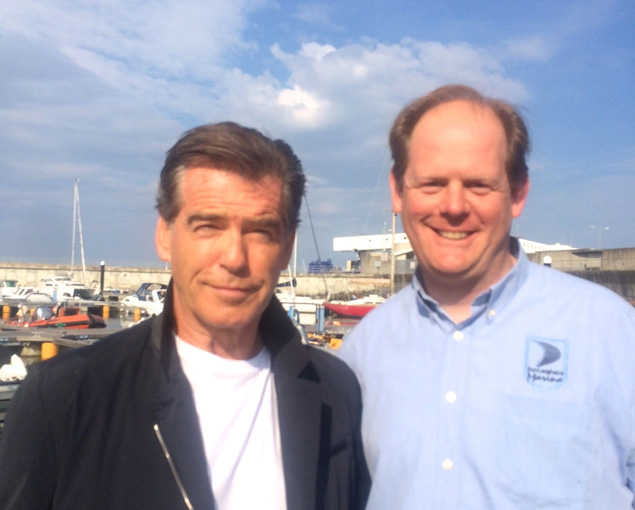 When you’re running a top marina, all sorts of people come to call…
When you’re running a top marina, all sorts of people come to call…
From a tourism point of view, the presence of the marina can be beneficial in several ways. Apart from its functional value, it is a symbol of peace and prosperity. The very idea of “picturesque poverty” is now rightly regarded as a Victorian obscenity, but the notion of a cruising yacht going harmlessly on her way with her crew enjoying the experience is an extremely reassuring concept in an increasingly disturbed world.
The quiet hint of a comfortable level of prosperity cannot be over-estimated. When Ireland plunged off the economic cliff with the collapse of the Celtic Tiger, tourism numbers plunged. After all, who wants to go on holiday in a country in the depressed grip of an economic recession? But as the green shoots of recovery strengthen, the mood lightens, and people increasingly want to be part of it, so the fact of more visiting boats is in itself an encouragement for further growth.
Currently, it looks as though there’ll be upwards of 600 visiting yachts of all shapes and sizes from more than 20 different countries using Dun Laoghaire Marina this year, including at least half a dozen superyachts. On average, the ordinary cruising boat stays 3 to 4 days, and while their crews find the draw of Dublin’s world-standard tourist attractions a significant appeal, they enjoy returning by DART to a fresh and lively port where the evening sailing programme may be getting under way.
Another particular attraction is that an Airport bus route has a stop within a very short distance ashore. Dun Laoghaire rates highly for its convenience for long-distance crew changes. When you’ve settled into the ways of the sea but realize that dealing with shore realities will shortly be on the agenda, it’s encouraging to know there’s a port ahead where not only can they assist with that, but they can provide helpful printed mini-pocket guides to get the best of Dun Laoghaire while you’re waiting there for your new crew to arrive.
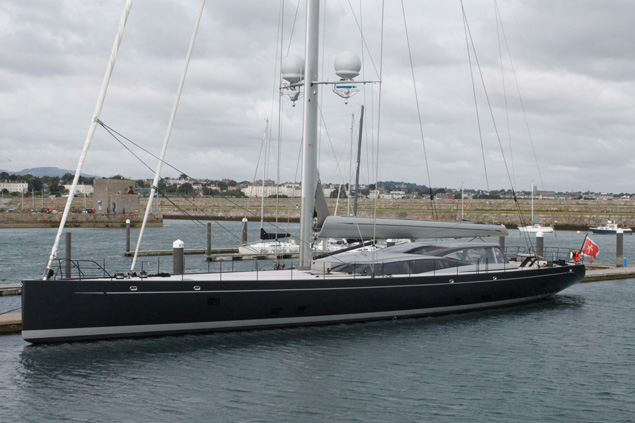 Big boats need grown-up facilities – Dun Laoghaire Marina can provide them
Big boats need grown-up facilities – Dun Laoghaire Marina can provide them
Of course, while the Marina makes a high priority out of being visitor-helpful, it also goes out of its way to be user-friendly for its own berth-holders, and one particular service is relied on by visitors and locals alike. Dun Laoghaire Marina maintains a list of accredited marine specialists and service providers in the immediate neighbourhood, and the welcome feeling of reassurance that such a list is there – even if you don’t have to avail of it – is something which adds to the attraction of the package, while its inclusion in the town’s economic activity and local employment is of real significance as marine experts in all trades from electronics through engineering and boat repair to sail-making are kept busy.
In all, it provides a welcome sense of reaching a centre of excellence when you enter the marina. As visiting cruisers make their way into Dun Laoghaire through late afternoon and early evening, those watching ashore will share the warming experience of another mini-voyage successfully completed. Not that departures and arrivals are restricted to morning and evening. At the height of summer, the Marina sees signs of life 24/7 as boats come and go at all hours depending on their destination and the timing of a favourable tide.
As for those who are actually at home there, Paal Janson has analysed the figure to provide a useful database for anyone studying boat ownership and use. In terms of sail versus power, he reckons in the good times the ratio was 60% sail to 40% power, but there’s no doubt that in recession, there was more of a decline in powerboat ownership than with sailing boats. But as the good time roll again, some of the powerboats appearing are extremely impressive.
Within the sailing boat category, the division between racing and pure cruiser is about 50/50, despite the fact that Dublin Bay Sailing Club’s programme is so firmly embedded in the Dun Laoghaire psyche that you’ll get boats racing with the DBSC fleet on a Thursday night that wouldn’t at all be seen as racers of any kind elsewhere.
It is the range of users for which Dun Laoghaire Marina caters which underlines the breadth of the boat-minded community attracted to its convenient facilities. Since 2007, one of the fixtures of the Marina’s extensive “floating forecourt” has been a Personal Lift which facilitates the Irish Wheelchair Association in getting disabled sailors aboard boats adapted for their use.
 The Irish Wheelchair Association and Dun Laoghaire Marina have combined forces to provide a personal lift and convenient berthing for a specially modified RIB to take wheelchair users to sea, and it is a very frequently-used facility.
The Irish Wheelchair Association and Dun Laoghaire Marina have combined forces to provide a personal lift and convenient berthing for a specially modified RIB to take wheelchair users to sea, and it is a very frequently-used facility.
The fact that this frequently-used setup is in Dun Laoghaire is a reminder of the marina’s inbuilt location advantage over every other marina in Ireland. Dun Laoghaire is conveniently at the heart of one of the largest populations in Ireland, and that population s right beside the sea. So if providers of specialist services of any kind for the boat population seek to increase their activities, they have to remind themselves that ultimately it is the numbers game which will be the key factor in their success.
Thus if you’re going to building up a sailing school – whether inshore or offshore or both – then by being Dun Laoghaire-based, you’re providing your courses within easy reach of a lively, potentially affluent, and numerically large sector of the population.
So although the longest-established of all Dun Laoghaire schools, the Rumball family’s Irish National Sailing School – runs its dinghy courses from facilities within the Inner Harbour beside its HQ, for its most recent ventures into offshore training it uses the marina for berthing requirement. And for several years now the marina has been the base for Ronan O Siochru’s Irish Offshore Sailing, which specialises in this area to such good effect that one of its training yachts, the 37ft Desert Star, was overall winner of the 33-boat Sailing Schools division in the Rolex Fastnet Race 2015.
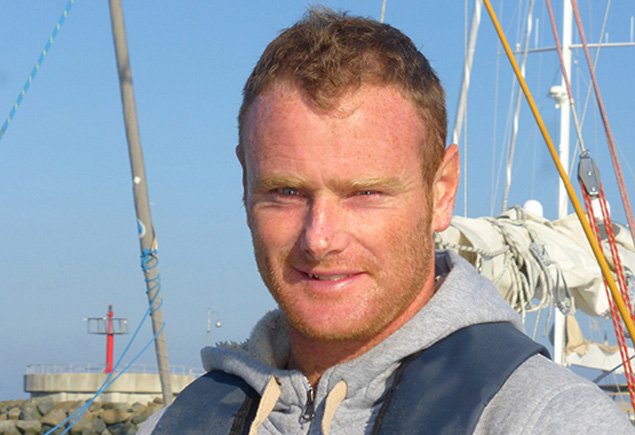 Ronan O Siochru of Irish Offshore Sailing, back in Dun Laoghaire Marineafter his class win in the Rolex Fastnet Race 2015. Photo W M Nixon
Ronan O Siochru of Irish Offshore Sailing, back in Dun Laoghaire Marineafter his class win in the Rolex Fastnet Race 2015. Photo W M Nixon
It was a matter of special pride for the Dun Laoghaire Marina staff that a boat which operated from their base should have achieved such international offshore acclaim, and since then standards have continued to rise, as the Irish National Sailing School are now also very much into the offshore game, with their J/109 lined up – like Desert Star – for participation in the Sailing Schools division in the Rolex Fastnet Race 2017 on Sunday 6th August.
In fact, while IOS’s Desert Star is mainly providing dedicated offshore courses, INSS’s Jedi is into the complete Dublin Bay experience of racing inshore and offshore at the heart of the J/109 and Dublin Bay SC fleet. Thus there was a satisfying sense of completeness at the prize-giving which concluded the Volvo Dun Laoghaire Regatta 2017 on July 9th, when Jedi received her prize as runner-up in the J/109s, as she was also one of the boats receiving the special re-print of the historic engraving of July 1828, recording the very first regatta of all in what had become Kingstown Royal Harbour.
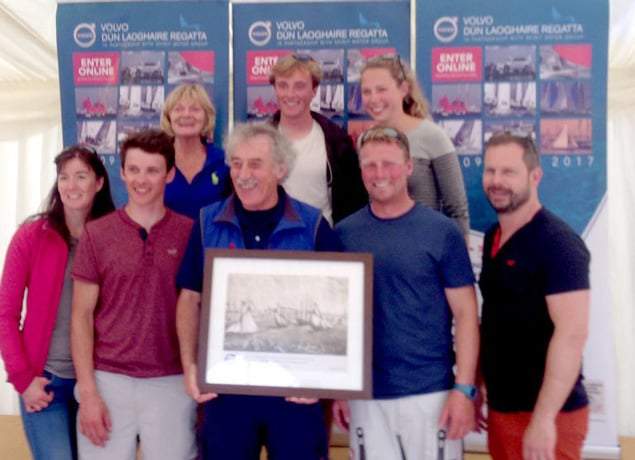 A satisfying sense of completeness. Alistair Rumball (centre) with the special Bicentenary Prize and the Irish National Sailing School crew of Jedi who won it
A satisfying sense of completeness. Alistair Rumball (centre) with the special Bicentenary Prize and the Irish National Sailing School crew of Jedi who won it
It was an image which encapsulated the key elements in the story of the harbour. In the long run, the problems with the shallow entrance to Dublin Port were overcome by dredging development, and the replacement of sailing ships by engine-powered vessels. But Dun Laoghaire remained of use to ships as it had been designated the official cross-channel Ferry Port in 1834, and until warship sizes outgrew it early in the 20th century, it was throughout the later 1800s a naval base, with the advantage of direct rail connection to the main naval base off Cobh in Cork Harbour.
However, although Dun Laoghaire Harbour was obliged to function within the size which had been decided for it in 1817, the increasing size of ships, together with the major changes in shore transport and acceptable road systems, increasingly restricted its potential as a commercial harbour and ferry port.
Then too, the attractive residential nature of Dun Laoghaire’s waterfront terraces of houses was once more in the ascendant. For a period, many had become offices, but with the commercial shipping aspects of harbour activity reducing, recent years have seen the reversion of the harbourside houses – many of them very handsome buildings indeed – to residential use.
 With berthing concentrated in the Marina, and the ferries gone, the close-fought fleet were able to enjoy Dun Laoghaire’s in-harbour finish. Photo David O’Brien/Afloat.ie
With berthing concentrated in the Marina, and the ferries gone, the close-fought fleet were able to enjoy Dun Laoghaire’s in-harbour finish. Photo David O’Brien/Afloat.ie
This has been particularly marked with the new property boom, but it was already under way when the last Holyhead ferry sailed in September 2014, and since then the fact that the Dun Laoghaire waterfront is no longer cluttered with ferry traffic has added to the area’s appeal as somewhere to live and enjoy the sea air and the views of recreational boating activity in the harbour. As for the background, we know that that recreational sailing use started at least as early at 1828, and continues today, busier than ever. But as for ferryport use, that didn’t begin until 1834, and it ended in 2014.
Admittedly the last relics of the ferry era are still much in evidence with the extensive shoreside marshalling yards at St Michael’s Pier and the former Ferry Terminal buildings still very much in existence. But as Dublin Port continues to develop its ferry and cruise liner berthing facilities at top speed, it is surely time for everyone in Dun Laoghaire to accept that their harbour’s future lies in another direction, a healthier direction for a place which is increasingly residential and recreational.
Whatever the outcome, the fact is that Dun Laoghaire Marina is now the main focal point of waterfront activity. In marina terms, it’s a distinctly grown-up sort of place. With its good depths and extensive berthing, it can confidently provide the RNLI with accessible-all-hours berthing for its reserve lifeboats – when Afloat.ie was visiting this week, there were two in port, ready for action at a moment’s notice. And during the winter, naval, coastguard and customs vessels know they can rely on its spaciousness and total shelter when required.
Thanks to its scale, it can cope with big boats and big events too. When Sidney Gavignet and his crew on the MOD 70 Oman Sailing were poised for a challenge at the Round Ireland Record in May 2016, they knew that they could base themselves in Dun Laoghaire marina without being under undue attention while they waited for the ideal conditions to materialise for what was a successful challenge.
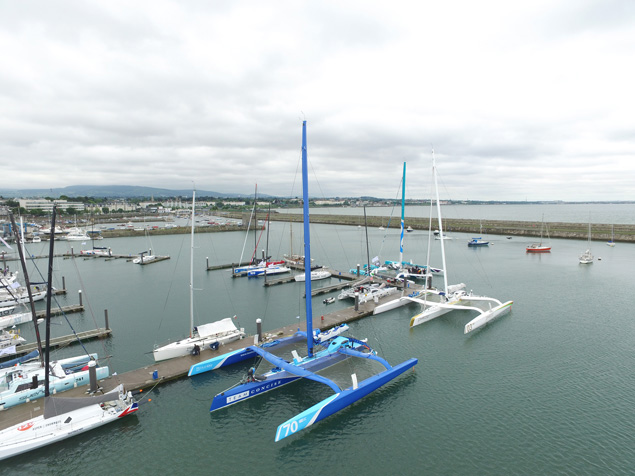 The three MOD 70s in Dun Laoghaire Marina before the Volvo Round Ireland Race in June 2016. Between them, they broke the Round Ireland Record three times in the summer of 2016.
The three MOD 70s in Dun Laoghaire Marina before the Volvo Round Ireland Race in June 2016. Between them, they broke the Round Ireland Record three times in the summer of 2016.
Yet when publicity was sought, as it was for the big boats in the Volvo Round Ireland Race in June 2016, the ideal setting was at the Royal Irish Yacht Club within the shelter of the marina when, despite inclement weather, there was an extraordinary gathering of
legendary race boats and sailing rock stars, all in one place at a berth which would have been untenable had it not been for Dun Laoghaire Marina’s sheltering arms.
So the contribution of the Marina to Dun Laoghaire’s rising status in international sailing deserves to be more widely recognised, as does the Marina’s significant contribution to many aspects of the local economy. But in making themselves and what they do more accessible to the general public, Paal Janson and his long-serving team are walking a tightrope, as they have to ensure urban-centre levels of security for the boats permanently berthed in their facility.
Glamour visitors may come and go, but the longterm berth-holders underpin the entire operation, and their needs are equally important. So perhaps it would be better to acknowledge he success Dun Laoghaire Marina achieves in what it sets out to do, and focus again on one up-coming event in particular. That is the start of the 2017 Rolex Fastnet Race on Sunday August 6th.
 Desert Star from Irish Offshore Sailing in Dun Laoghaire Marina rounding the rock in the Rolex Fastnet Race 2015, on her way to winning the Sailing Schools class of 33 boats…………..
Desert Star from Irish Offshore Sailing in Dun Laoghaire Marina rounding the rock in the Rolex Fastnet Race 2015, on her way to winning the Sailing Schools class of 33 boats………….. …..which was very pleasing indeed for the Marina General Manager back home. Photo: David O’Brien/Afloat.ie
…..which was very pleasing indeed for the Marina General Manager back home. Photo: David O’Brien/Afloat.ie
Of eleven entries with Irish involvement, six will be boats based in Dun Laoghaire Marina. That is clear evidence of the punch packed by the affluence of the Dun Laoghaire/Rathdown region, and the enthusiasm now being generated within Dun Laoghaire harbour.
And of those six boats, two will be in the Sailing Schools Division - Irish Offshore Sailing’s Desert Star, and Irish National Sailing School’s Jedi. There must be few marinas in Europe, other than those around the Solent, which are sending forth two entries for the Sailing Schools’ prize in the Fastnet. Yet Dun Laoghaire Marina can do it with style, knowing that one of its boats was the overall winner last time round.



























